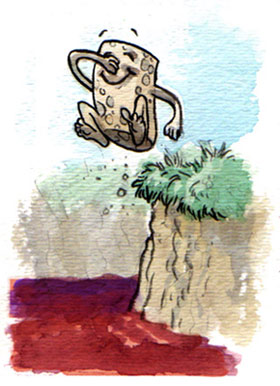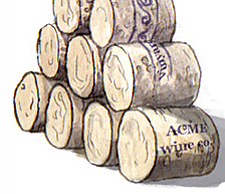

The Adventures of Mr. Cork, Part 1: No Air Allowed: "Corks never inhale, and they exhale only once (right after bottling)."
Corks Do NOT Breathe - Part 2
by
Richard Grant Peterson, PhD
October 13, 2008
 evelopment of beautiful “Bottle Bouquet” is a primary goal of long term wine cellaring. It’s well established that bottle bouquet requires the absence of oxygen to develop. Wine would die early and fail to age properly in bottle (being unable to develop bottle bouquet) if corks were to breathe air, so it’s a good thing they don’t. Although sound wine corks don’t breathe, I admit they have a confusing way of showing it. Just imagine: corks never inhale, and they exhale only once (right after bottling). The exhale is slow, lasts a few weeks and is only a partial one. To understand this, look at the cork structure.
evelopment of beautiful “Bottle Bouquet” is a primary goal of long term wine cellaring. It’s well established that bottle bouquet requires the absence of oxygen to develop. Wine would die early and fail to age properly in bottle (being unable to develop bottle bouquet) if corks were to breathe air, so it’s a good thing they don’t. Although sound wine corks don’t breathe, I admit they have a confusing way of showing it. Just imagine: corks never inhale, and they exhale only once (right after bottling). The exhale is slow, lasts a few weeks and is only a partial one. To understand this, look at the cork structure.
Corks are cut from the thick, non-living bark of cork oak trees, Quercus Suber, which grow naturally on land around the Mediterranean Sea. The bark of cork differs from that of other
 trees in that most tree bark contains fibers running lengthwise like the wires in a cable. Cork bark does not. Rather, cork bark is made up completely of myriads of tiny cells, each imprisoning within its walls a microscopic bit of air. Those bits of air are natural, having been imprisoned there as the bark cells grew on the tree. There are about 200 million minute cells in a one inch cube of natural cork, the cells averaging 1/1000 inch in diameter. Each cell is separated from its neighbors by a thin, thread-like but extremely strong membrane of resinous materials which binds the cork cells together. Just over 50 percent of the volume of a piece of cork is this captive air within the tiny cells.
trees in that most tree bark contains fibers running lengthwise like the wires in a cable. Cork bark does not. Rather, cork bark is made up completely of myriads of tiny cells, each imprisoning within its walls a microscopic bit of air. Those bits of air are natural, having been imprisoned there as the bark cells grew on the tree. There are about 200 million minute cells in a one inch cube of natural cork, the cells averaging 1/1000 inch in diameter. Each cell is separated from its neighbors by a thin, thread-like but extremely strong membrane of resinous materials which binds the cork cells together. Just over 50 percent of the volume of a piece of cork is this captive air within the tiny cells.
Remarkably, each cork cell is tetrakaidecahedral (14 sided). The math majors among us realize that it takes 14 sided bodies to exactly fill a space with uniform bodies of minimal surface dimensions and without interstices. The cells snug together perfectly to fill the whole space without leaving any voids at all. A piece of cork is completely cellular with no “empty” spaces between the cells. This seems to me a major reason why corks don’t transmit air: the path through a cork is just too tortuous for significant numbers of gas molecules to work their way through, even if pressure is applied to one end of the cork.
Champagne Proof Positive
Champagne people have known since Dom Perignon that carbon dioxide gas doesn’t escape from a bottle of bubbly during many years’ storage even though the pressure inside a bottle of Champagne or Sparkling Wine is as much as 5 atmospheres (75 psi.) If CO2 gas can’t get through a cork and out of a bottle with 75 psi of pressure pushing on it, how could O2 get into a bottle with only a few ounces of outside pressure pushing it? CO2 molecules are physically larger than O2 molecules - but only a little larger, and that factor doesn’t explain it. If cork contained longitudinal gaps, voids or fibers, the escape route for gases would be easier. But that only happens with damaged corks (read: cheap) which might contain cracks. Since cracks in corks are usually obvious, proper inspection and grading eliminates defective corks prior to their shipment to a winery.Several Other Properties Of Cork Need To Be Kept In Mind
With a specific gravity of only .25, cork is one of the lightest of all solid substances.
***
The Cork Institute reported (1941) that a 1” cube of cork had been compressed at 14,000 psi without breaking. After release of the pressure, the cube returned to 90 percent of its original 1” height and showed no appreciable change in its other dimensions. Some of the cellular “cork air” escaped during compression but most remained trapped and compressed within the cork’s cells, even at this extreme pressure. This helps us understand the myth of corks breathing.
***
Cork does not harden or deteriorate under ordinary pressures. This partially explains its facility for use as stoppers and flooring materials.
***
Cork is not absolutely impervious to moisture penetration, but its cellular structure gives it high resistance to penetration by water and wine. I have noticed many wine corks that were “wine stained” less than one inch of their length after residing in a bottle of wine for twenty years. Wine corks are mostly 1 ¾ inches long, but sometimes as long as 2 ¼ inches, which provides a sufficient length of sound cork to preserve a solid seal over time.
***
Cork’s coefficient of friction is much greater than that of rubber or leather, because the exposed surface cells act like tiny suction cups. Because of this, it is necessary to lubricate the outsides of new wine corks with paraffin and/or silicone prior to use. We’d never get them out of a bottle otherwise.
***
Next to vacuum, a “dead” air space minutely divided is one of the most efficient nonconductors of heat. Cork cells, since they contain air, also tend to absorb impact or vibration which helps keep the corks well seated in wine bottles during shipping.
 chemical reaction between them in wine is complex but this simplification doesn’t change the gist of the story. Winemakers have long noticed that the free SO2 content of newly bottled table wine diminishes by 5 or 6 ppm within the first month after bottling, then by only 1 ppm or less in the months after that. The accepted explanation is that this initial loss of SO2 is due to the pickup of O2 by the wine as it passes through pumps and hoses while moving from the bottling tank through the bottling operation. The SO2 is lost from the wine by reacting with, and removing, any O2 that gets in.
chemical reaction between them in wine is complex but this simplification doesn’t change the gist of the story. Winemakers have long noticed that the free SO2 content of newly bottled table wine diminishes by 5 or 6 ppm within the first month after bottling, then by only 1 ppm or less in the months after that. The accepted explanation is that this initial loss of SO2 is due to the pickup of O2 by the wine as it passes through pumps and hoses while moving from the bottling tank through the bottling operation. The SO2 is lost from the wine by reacting with, and removing, any O2 that gets in.
What if the wine was oxygen-free at the time of bottling? There should be no loss of SO2 since there was no O2 to remove. At Beaulieu Vineyard, I ran into a stone wall that was hard to believe at first: wine lost this SO2 following bottling even when we carefully excluded air from pumps, hoses and equipment. That is, virtually no air had entered the wine prior to bottling, yet we still had that same loss of SO2 in the first month after bottling. Somehow oxygen was entering the wine in the first weeks after bottling to the extent that 5-6 ppm of SO2 was used up in getting rid of that O2. Where the !@&# did that O2 come from?
Another mystery: many wines containing traces of H2S (“rotten egg” smell) tend to lose the H2S immediately after bottling with corks but not with screw caps. Obviously, O2 enters the bottle and oxidizes the H2S, getting rid of it. But where did the O2 come from? How could O
 READER FEEDBACK: To post your comments on this story,
click here
READER FEEDBACK: To post your comments on this story,
click here
Print this article | Email this article | More about America | More from Richard Grant Peterson, PhD















